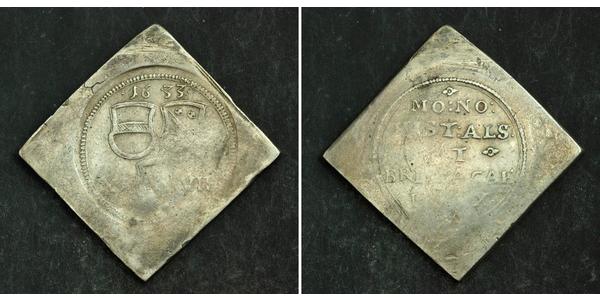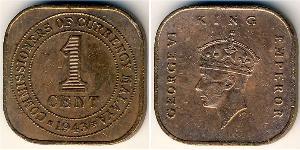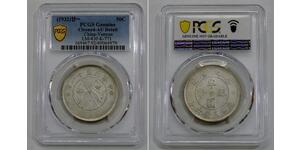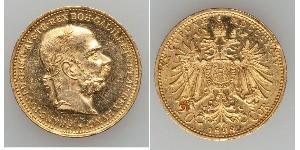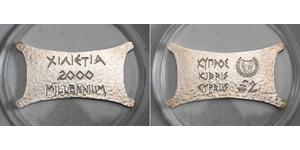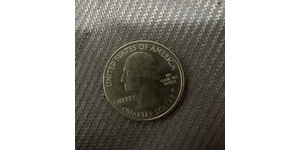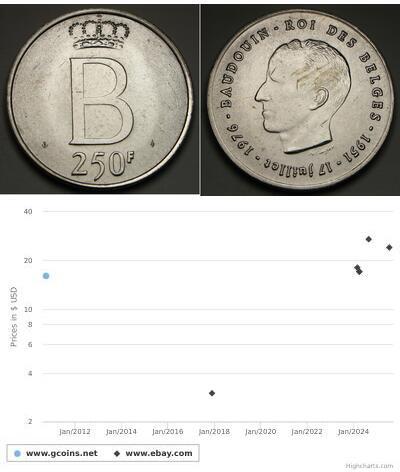(продана за $257.0)
1633, Breisach (Swedish occupation). Scarce Silver Klippe (48 Kreuzer) Coin. R!
Mint Year: 1633
Mint Place: Breisach City (Germany)
Denomination: Siege Klippe of 48 Kreuzer
Reference: Berstett 85, Brause-Mansfeld, pl. IV, 6, KM-3.1. RR!
Condition: Weakly struck due to an uneven planchet, tooling/welding scar at 12 o'clock (probably a removed suspension loop), otherwise VF.
Diameter: 29mm x 30mm
Weight: 16.11gm
Material: Silver
Obverse:Coat-of-arms of Austria and Elsass above that of Breisach. All around privy mark (clover) and pellet. Value split in fields.
Legend: • 16 • 33 • (clover) • XL-VIII
Reverse: Legend in five lines within circle.
Legend: MO : NO : VEST : ALS : * ET * BRISIACAE . INDEX . - * -
In 1633, the French besieged the strategically important fortress of Breisach. In October of that year, the combined forces of the Spanish, under the Duke of Feria, and the Bavarians successfully lifted the siege.
The Thirty Years' War (1618–1648) was one of the most destructive conflicts in European history. The war was fought primarily in what is now Germany, and at various points involved most of the countries of Europe. Naval warfare also reached overseas and shaped the colonial formation of future nations. The origins of the conflict and goals of the participants were complex, and no single cause can accurately be described as the main reason for the fighting. Initially, the war was fought largely as a religious conflict between Protestants and Catholics in the Holy Roman Empire, although disputes over the internal politics and balance of power within the Empire played a significant part. Gradually, the war developed into a more general conflict involving most of the European powers. In this general phase, the war became more a continuation of the Bourbon–Habsburg rivalry for European political pre-eminence, and in turn led to further warfare between France and the Habsburg powers, and less specifically about religion. A major impact of the Thirty Years' War was the extensive destruction of entire regions, denuded by the foraging armies (bellum se ipsum alet). Episodes of famine and disease significantly decreased the populace of the German states, Bohemia, the Low Countries and Italy, while bankrupting most of the combatant powers. While the regiments within each army were not strictly mercenary in that they were not guns for hire that changed sides from battle to battle, the individual soldiers that made up the regiments for the most part probably were. The problem of discipline was made more difficult still by the ad hoc nature of 17th-century military financing. Armies were expected to be largely self-funding from loot taken or tribute extorted from the settlements where they operated. This encouraged a form of lawlessness that imposed often severe hardship on inhabitants of the occupied territory. Some of the quarrels that provoked the war went unresolved for a much longer time. The Thirty Years' War was ended with the treaties of Osnabrück and Münster, part of the wider Peace of Westphalia.
Breisach (formerly Altbreisach) is a town with approximately 16,500 inhabitants, situated along the Rhine in the Rhine Valley, in the district Breisgau-Hochschwarzwald, Baden-Württemberg, Germany, about halfway between Freiburg and Colmar—20 kilometers away from each—and about 60 kilometers north of Basel near Kaiserstuhl. A bridge leads over the Rhine to Neuf-Brisach, Alsace.
Its name is Celtic and means breakwater. The root Breis can also be found in the French word briser meaning to break.
The seat of a Celtic prince was at the hill on which Breisach lies. The Romans maintained an auxiliary castle on Mons Brisiacus (which came from the celtic word Brisger which means waterbreak) The Staufer founded Breisach as a city in today's sense. But there had already been a settlement with a church at the time. An 11th century coin from Breisach was found in the Sandur hoard.
In the early 13th century, construction on the St. Stephansmünster, the cathedral in Breisach, started. In the early 16th century, Breisach was a significant stronghold of the Holy Roman Empire. On December 7, 1638, Bernhard of Saxe-Weimar, who was subsidized by France, conquered the city, which Ferdinand II and General Reinach had defended well, and tried to make center of a new territory. After Bernhard's death in 1639, his general gave the territory to France, which saw it as its own conquest. In the Peace of Westphalia in 1648, Breisach was de jure given to France.
From 1670, Breisach was integrated into the French state in the course of the politics of Reunions. In the Treaty of Ryswick in 1697, Breisach was returned to the Holy Roman Empire, but then reconquered on September 7, 1703 by General Villars at the beginning of the War of the Spanish Succession. At the Treaty of Rastatt on March 7, 1714, Breisach became once again part of the Empire. Meanwhile, France founded its own fortress, Neuf-Brisach ("New Breisach"), on the left shore of the Rhine. In 1790, Breisach was part of Further Austria. In the revolutionary wars in 1793, Breisach was widely destroyed and then, in 1805, annexed to the de facto re-established state of Baden.

|
Добавив:
anonymous 2016-06-23 |
536 монет було додано з 2025-06-11 по 2025-06-18
Одна з них:

